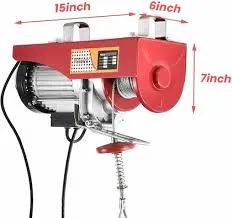


The Electric Winch A Versatile Tool for Modern Day Tasks
In today’s world, where efficiency and convenience are paramount, tools like the electric winch have found their place as indispensable devices in numerous industries and applications. An electric winch is a powerful tool used primarily for lifting, pulling, and hoisting loads with minimal human effort. From construction sites to recreational activities, electric winches provide a simple yet effective solution to complex lifting tasks.
Understanding Electric Winches
At its core, an electric winch consists of a motor that powers a drum or spool, which winds a cable or rope. The mechanism operates on the principles of mechanical advantage, enabling users to lift heavy objects with relative ease. Unlike manual winches that require significant physical strength and effort, electric winches automate this process, thereby increasing safety and productivity.
The advantages of electric winches are numerous. Firstly, they offer high efficiency; electric motors can provide consistent power and torque, making it easier to manage heavy loads. Whether you're lifting steel beams at a construction site or pulling your vehicle out of a muddy situation, an electric winch can handle the task at hand with minimal strain on the operator.
Applications of Electric Winches
Electric winches are used in a variety of settings. In the construction industry, they are essential for hoisting materials to great heights. Builders rely on these winches to position heavy loads accurately, thus streamlining operations and reducing the risk of accidents associated with manual handling.

In the automotive world, electric winches are widely used in off-road applications. Off-road enthusiasts often equip their vehicles with electric winches to extricate themselves from challenging terrains. Whether stuck in mud, sand, or snow, an electric winch can provide the necessary pulling power to recover vehicles safely.
Additionally, electric winches have become prevalent in marinas and boatyards. They are employed to lift boats out of the water for maintenance, repair, or storage. This function is crucial for maintaining the longevity and safety of watercraft, making electric winches valuable tools in maritime operations.
Features and Considerations
When selecting an electric winch, several features should be considered to ensure optimal performance for the intended task. Load capacity is paramount; users must choose a winch capable of handling the weight of the objects they wish to lift or pull. Additionally, speed and power ratings should align with the application requirements, as these factors influence efficiency.
Safety features are another critical aspect. Most modern electric winches are equipped with automatic brakes, ensuring that loads remain secure when not actively being lifted. Overload protection and remote control capabilities enhance safety, allowing users to operate the winch from a safe distance.
Conclusion
The electric winch exemplifies the evolution of tools designed to make our lives easier and more efficient. With its diverse applications across various fields, it stands as a testament to engineering ingenuity. As technology continues to advance, we can expect even more innovative features and improvements in electric winch designs, further solidifying its role as a must-have device in both professional and recreational settings. Whether you’re lifting heavy equipment on a job site or recovering a vehicle in a tricky situation, the electric winch proves to be an invaluable ally. Its ability to simplify complex tasks not only saves time but also enhances safety, making it clear why electric winches are a critical component in today’s modern toolkit.



